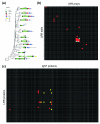A cell surface interaction network of neural leucine-rich repeat receptors
- PMID: 19765300
- PMCID: PMC2768988
- DOI: 10.1186/gb-2009-10-9-r99
A cell surface interaction network of neural leucine-rich repeat receptors
Abstract
Background: The vast number of precise intercellular connections within vertebrate nervous systems is only partly explained by the comparatively few known extracellular guidance cues. Large families of neural orphan receptor proteins have been identified and are likely to contribute to these recognition processes but due to the technical difficulty in identifying novel extracellular interactions of membrane-embedded proteins, their ligands remain unknown.
Results: To identify novel neural recognition signals, we performed a large systematic protein interaction screen using an assay capable of detecting low affinity extracellular protein interactions between the ectodomains of 150 zebrafish receptor proteins containing leucine-rich-repeat and/or immunoglobulin superfamily domains. We screened 7,592 interactions to construct a network of 34 cell surface receptor-ligand pairs that included orphan receptor subfamilies such as the Lrrtms, Lrrns and Elfns but also novel ligands for known receptors such as Robos and Unc5b. A quantitative biochemical analysis of a subnetwork involving the Unc5b and three Flrt receptors revealed a surprising quantitative variation in receptor binding strengths. Paired spatiotemporal gene expression patterns revealed dynamic neural receptor recognition maps within the developing nervous system, providing biological support for the network and revealing likely functions.
Conclusions: This integrated interaction and expression network provides a rich source of novel neural recognition pathways and highlights the importance of quantitative systematic extracellular protein interaction screens to mechanistically explain neural wiring patterns.
Figures





Similar articles
-
Construction of a large extracellular protein interaction network and its resolution by spatiotemporal expression profiling.Mol Cell Proteomics. 2010 Dec;9(12):2654-65. doi: 10.1074/mcp.M110.004119. Epub 2010 Aug 27. Mol Cell Proteomics. 2010. PMID: 20802085 Free PMC article.
-
G-protein-coupled estrogen receptor 1 is involved in brain development during zebrafish (Danio rerio) embryogenesis.Biochem Biophys Res Commun. 2013 May 24;435(1):21-7. doi: 10.1016/j.bbrc.2013.03.130. Epub 2013 Apr 11. Biochem Biophys Res Commun. 2013. PMID: 23583372
-
Essential role for the d-Asb11 cul5 Box domain for proper notch signaling and neural cell fate decisions in vivo.PLoS One. 2010 Nov 19;5(11):e14023. doi: 10.1371/journal.pone.0014023. PLoS One. 2010. PMID: 21124961 Free PMC article.
-
Neurexins, neuroligins and LRRTMs: synaptic adhesion getting fishy.J Neurochem. 2011 Jun;117(5):765-78. doi: 10.1111/j.1471-4159.2010.07141.x. Epub 2011 Jan 19. J Neurochem. 2011. PMID: 21155806 Free PMC article. Review.
-
Cell surface protein-protein interaction profiling for biological network analysis and novel target discovery.Life Med. 2024 Aug 29;3(4):lnae031. doi: 10.1093/lifemedi/lnae031. eCollection 2024 Aug. Life Med. 2024. PMID: 39872863 Free PMC article. Review.
Cited by
-
Avidity-based extracellular interaction screening (AVEXIS) for the scalable detection of low-affinity extracellular receptor-ligand interactions.J Vis Exp. 2012 Mar 5;(61):e3881. doi: 10.3791/3881. J Vis Exp. 2012. PMID: 22414956 Free PMC article.
-
Whole genome bisulfite sequencing of Down syndrome brain reveals regional DNA hypermethylation and novel disorder insights.Epigenetics. 2019 Jul;14(7):672-684. doi: 10.1080/15592294.2019.1609867. Epub 2019 May 6. Epigenetics. 2019. PMID: 31010359 Free PMC article.
-
Deconstruction of the beaten Path-Sidestep interaction network provides insights into neuromuscular system development.Elife. 2017 Aug 15;6:e28111. doi: 10.7554/eLife.28111. Elife. 2017. PMID: 28829740 Free PMC article.
-
A benchmarked protein microarray-based platform for the identification of novel low-affinity extracellular protein interactions.Anal Biochem. 2012 May 1;424(1):45-53. doi: 10.1016/j.ab.2012.01.034. Epub 2012 Feb 17. Anal Biochem. 2012. PMID: 22342946 Free PMC article.
-
Increased Expression of Fibronectin Leucine-Rich Transmembrane Protein 3 in the Dorsal Root Ganglion Induces Neuropathic Pain in Rats.J Neurosci. 2019 Sep 18;39(38):7615-7627. doi: 10.1523/JNEUROSCI.0295-19.2019. Epub 2019 Jul 25. J Neurosci. 2019. PMID: 31346030 Free PMC article.
References
-
- Lein ES, Hawrylycz MJ, Ao N, Ayres M, Bensinger A, Bernard A, Boe AF, Boguski MS, Brockway KS, Byrnes EJ, Chen L, Chen L, Chen TM, Chin MC, Chong J, Crook BE, Czaplinska A, Dang CN, Datta S, Dee NR, Desaki AL, Desta T, Diep E, Dolbeare TA, Donelan MJ, Dong HW, Dougherty JG, Duncan BJ, Ebbert AJ, Eichele G, et al. Genome-wide atlas of gene expression in the adult mouse brain. Nature. 2007;445:168–176. doi: 10.1038/nature05453. - DOI - PubMed
Publication types
MeSH terms
Substances
Grants and funding
LinkOut - more resources
Full Text Sources
Other Literature Sources
Molecular Biology Databases
Research Materials

